
Mainz – the pink queen of the Rhine
Mainz is the largest city of Rhineland Palatinate, Gutenberg’s home-town and Germany’s wine capital. Some people call it a pink city. What is the reason for this? In this post, I will look at Mainz through rose-colored glasses to find out.

Old Town
Let’s start on one summer Sunday morning. Cobbles under my feet don’t make it easy to walk the streets of Old Town, especially in hills. The bells from church towers scare the pigeons. Apart from them, there is almost no one around. All shops are closed. Only cafes and restaurants have open doors and tables outside.

Now there is only a queue in front of a bakery, but by lunchtime, they all will be fully packed with locals who come for a chat with friends and Italian ice-cream. My new favourite flavour is the pink raspberry sorbet. However, the most popular ice-cream in Mainz is by the N’Eis – made from natural ingredients straight from this region.


When you enter the pedestrian area and follow the Augustinerstr., you encounter narrow streets, hidden courtyards and remnants of previous eras. Timber-framed houses look like painted with crayons. Pink facades match the fairy tale style. At Kirschgarten (‘cherry orchard’) there is the oldest house in the city which dates back to 1500. Its window boxes are often filled with pink or red flowers.



You can never get lost in this city because street labels are coloured red (perpendicular) and blue (parallel to the Rhine).
Almost every little square in Mainz has a fountain. One of the cutest is “The three little girls with umbrella” at the Ballplatz.

Just behind the corner at the Schillerplatz, there is the most famous Fastnachtsbrunnen – the Carnival Fountain. Following the local traditions, on 11th November at 11:11, it is where the 5th season of the year starts in the city – the carnival. The fountain consists of over 200 small sculptures inspired by local mythology.

The Market and churches
The heart of the city is the Market Square with ancient St. Martin’s Cathedral built from pink-tinged sandstone. It was started in 975 AD and now over 1000 years later citizens can still appreciate its glory. Visitors can enter the church for free. There is also a museum, which can be seen for free during the night of museums.


On weekdays – Tuesday, Friday and Saturday mornings the square turns into a farmers’ market. Locals sell their products under striped umbrellas. The stalls have a huge selection of fresh fruit, vegetables and flowers. On Saturday mornings people gather for a cozy breakfast – Mainzer Marktfrühstück to chat, eat a sausage and drink wine produced in this area.


Although Mainz is a small city, its inhabitants come from all over the world. This international culture is reflected also in city churches. The services are offered in German, English, Italian, Polish, Croatian, just to mention some. Many churches are built from the same sandstone as the cathedral. The one described in every city guide is St. Stephan’s church famous for blue stained glass windows created by Marc Chagall.


Johannes Gutenberg
Mainz has also something for book lovers. Nearby the cathedral there is a museum of Johannes Gutenberg who revolutionised the printing technology. His Bibles from the 15th century are part of the exhibition. The museum has also a little workshop where you can try yourself some old printing techniques.

Every June the city celebrates the Johannisnacht. It is a wonderful summer festival with live concerts, book markets, artists’ market with hand-made products, amusement park and fireworks!- a common attraction by the Rhine. Some other events when you can watch them are Rhine in Flames and Mainz Summer Lights.

Cherry blossoms
Every spring thousands of tourists in Germany who want to enjoy cherry blossoms go to Bonn. Not many know that Mainz has its cherry blossom street too – Ritterstr. It is not so popular, so you don’t have to queue for a pretty photo of pink petals.

Gardens of Mainz
My absolute favourite spot in Mainz is the Botanic Garden. It belongs to JGU and is located on the campus. It is open all year round free of charge. The collection includes over 8000 species. It is a great place for botanic photography. Whenever I go there anything pink always grabs my attention.



On warm days you can explore outdoor parts, with flowers and trees. If you are lucky you can meet a squirrel or a rabbit. And of course colourful butterflies. In the case of rain, there is always a chance to enter greenhouses with succulents, ferns, tropical plants or Alpine flora. The events calendar is full of festivals and educational activities for kids.


Mainz has many green spots and gardens. Another worth recommending is the City Park (Stadtspark) with a rose garden, rhododendrons, pink flamingos and a birdhouse with talking parrots. Some wild parrots live in the park as well – rose-ringed parakeets. They are bright green, sing very loud and are a danger to other local bird species. Every summer the park hosts the biggest wine market. But it is not just wine that you can get there. It is also full of books, hand-made cosmetics and garden decorations.



Mainz surroundings
For a pink sunset stroll, you can choose the popular Rhine Promenade or better the fields around the football stadium. The latter is less crowded and the views are spectacular. It is also a great place for sport’s activities: cycling, jogging, Nordic walking. The orchards in nearby Finten are especially pretty in springtime with all the blossoms. Every year different plants are grown there. Sometimes the fields are full of colza, another time of pink cloves.

Now you know why Mainz is called a pink city. It is full of pink buildings, flowers and wine!




